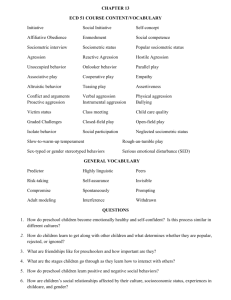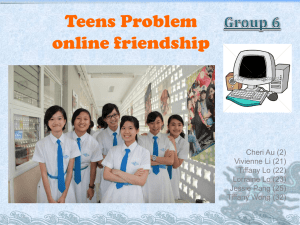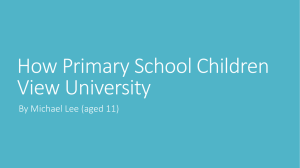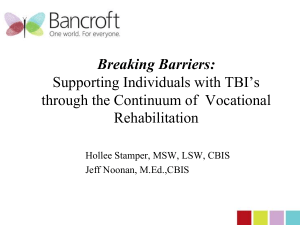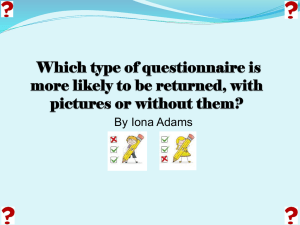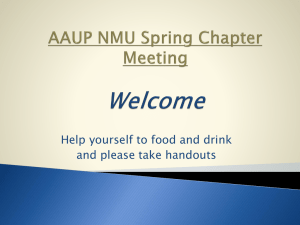Social Skills - Friendship - Resilience
advertisement
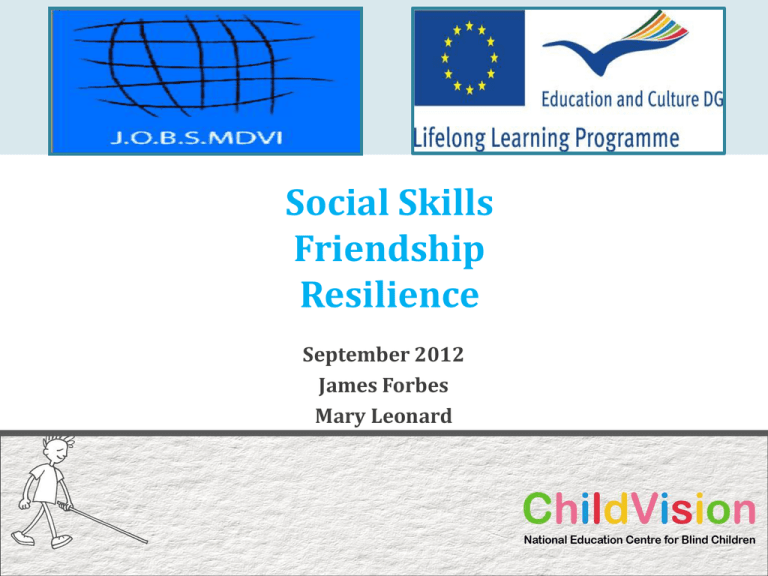
Social Skills Friendship Resilience September 2012 James Forbes Mary Leonard Defining social skills • Any skill facilitating interaction and communication with others • Absence of undue conflict or disharmony • Social skills are key to learning Why Social Skills? Building relationships Building self esteem Negotiating the norms of society Learning from the past through cycles of action and reflection that lead to new actions (Senge 2004) Which Social Skills? I found a moon rock in my nose For Whom? • ‘The better buttered bread scenario’ How do we teach social skills? • • • • • Modelling Coaching Circle Time Role Play Peer training Developing insights Conflict resolution Role Play Decision making Interpersonal Skills Communication Skills Resilience Factors associated with resilience • • • • • • • Positive attitude Optimism Ability to regulate emotions Ability reinterpret failure Flow T.O.M. High locus of control Friendship • No one would choose to live without friends” (Aristotle (384322 BC). • Friends are those “ who spontaneously seek the company of one another; furthermore, they seek proximity in the absence of strong social pressure to do so” (Hartup, 1975, p.11). • Heslop (2005) asserts that, “research has consistently shown people with learning difficulties to be lonely and lacking friends” (p.27) • “The presence of at least one close relationship provides a child with an important source of emotional support, and may offer him/her a buffer against the deleterious effects of peer isolation/rejection” (Howes, 1998) Insights from Literature • People with learning disabilities frequently identify making friendships as among their most important concerns (Cummins & Lau, 2003); • Many VI students feel lonely and isolated from their sighted peers (George & Duquette, 2006); • Social and emotional disadvantage flows from having fewer friends and fewer opportunities to socialise (Corn & Koenig, 1996); • Negative self image, feelings of personal unattractiveness, an awareness of being different in socially disadvantaged ways, a limited experience of physical activity, and an overdependence on sighted others are some of the ways in which visually impaired young people have identified their sense of isolation (Rosenblum, 2000). Themes • Reciprocity as a key feature of friendship (Kef et al., 2000). • Conflict resolution – traditional role of friendship (Lifshitz et al., 2007). • Social identity (Buultjens et al., 2002). • Technology, specifically the internet and social network sites may be changing traditional understandings of friendship (Valkenberg, 2005). RESEARCH DESIGN SOCIOMETRY CARE STAFF YOUNG PEOPLE SOCIAL INTERACTION OBSERVATIONS QUESTIONNAIRES/ INTERVIEWS VOCATIONAL TUTORS METHODOLOGY (i) Sociometric analysis (with young people) • Who do you like to spend your time with socially? • Who do you like to work with in the vocational unit? [each young person could make two positive nominations per question] Non-participant observation (by staff) • During breakfast in the house • At 8 pm in the residential house lounge [over a period of 3 weeks (Mon-Friday] [to observe seating preferences] METHODOLOGY (ii) Questionnaires (distributed to staff) Staff were asked to predict the positive nominations that were made by the young adults in the two different contexts to ascertain their knowledge of social dynamics. Semi-structured interviews (using incomplete sentences) e.g. • A friend is … • I would like my friend to be... • My friends at home are…… Data: Semi structured interviews A friend...... • has physical (pretty) and personal qualities (plays the whistle: is a good singer) • is good company, both humorous and helpful (helps with cleaning my bedroom; zips up my jacket); • engages in shared activity frequently in a social context (we go dancing; go shopping; drink at the Goose); • can be trusted and is honest. Data: sociometry A B C A 1 B 1 D E F 2 A B A 1 2 B 1 2 C 1 C 1 D 2 1 D 1 E 2 1 E 2 F Score 1 0 5 7 C 2 1 0 Fig 1: vocational context F 1 Score 2 D E 2 2 2 2 1 2 5 7 1 3 Fig 2: social context 1 = 1st choice nomination: 2 = 2nd choice nomination A - C = Female D – F = Male Shaded and outlined with bold choice number = reciprocity 1:1 or 1:2 Shaded with no outline = reciprocity but with different choices e.g. 1:2 F 0 Data: staff questionnaires Student Sociometric data: Vocational unit Questionnaires. Staff predictions. Vocational unit Sociometric data. Social Questionnaires. Staff predictions. Social Student A 5= 5 4 5 Student B 2 2 2 3 Student C 1 1 1 2 Student D 3 3 5 4 Student E 4 4 3 1 Student F 5= 6 6 6 Rank order comparison between sociometric and questionnaire data. 1 = highest rank in respect of received positive nominations 6 = lowest rank in respect of received positive nominations Student A- C: female Student D – F: male Data: Semi structured interviews A friend...... • has physical (pretty) and personal qualities (plays the whistle: is a good singer) • is good company, both humorous and helpful (helps with cleaning my bedroom; zips up my jacket); • engages in shared activity frequently in a social context (we go dancing; go shopping; drink at the Goose); • can be trusted and is honest. I would like my friend to be…. • • • • • • reliable honest ring each other more often give me a phone call send an e-mail I would like for us to meet up in the future when we are finished in here. My friends at home… • I know a lot of people at home but they wouldn’t really be my friends. • When I moved away I lost contact with a lot of my friends. • When I returned to my old school and met up with people there had been a lot of changes in 2 years. • I don’t see too much of her; I miss her. • I send text messages and emails if I’m not too busy. • I am teaching them, giving them experiences of people with a disability. I am a guinea pig explaining my disability. People tend to talk about me. CONCLUSIONS FROM THE DATA • Even within small social groupings, people can become socially isolated from their peers. • Female students are generally perceived to be more attractive as friends. • Patterns of friendship endure across different phases of the young people’ lives. • The young people use a range of electronic media to communicate with their friends. • Social contact with ‘home’ friends is especially important for the female students. • Friendships extend between and across genders. •Young people value friends who have both personal attributes and qualities; they are good company, humorous, honest and reliable. • Staff involved were generally correctly able to identify social patterns and preferences within their respective groups. •Support from social networks can help to mitigate a loss of identity and improve coping strategies. • The limited scope of the inquiry does not permit generalisations to be made to other groups of visually impaired young people. Practice at ChildVision • Young people need to continue to be encouraged to access local community social facilities and functions in order to increase their social network and enhance their social skills. • Strategies should be explored to enhance the social status of those marginalised within the peer group. This should be the responsibility of both adults and peers. • Staff need to be mindful of the need to monitor young people who appear detached from their peer group and intervene where appropriate to do so. This is a multi-professional responsibility. • Opportunities should be made available to elicit the views of young people about issues concerning their lives. In conclusion….. Social Skills - bad Social Skills - good
